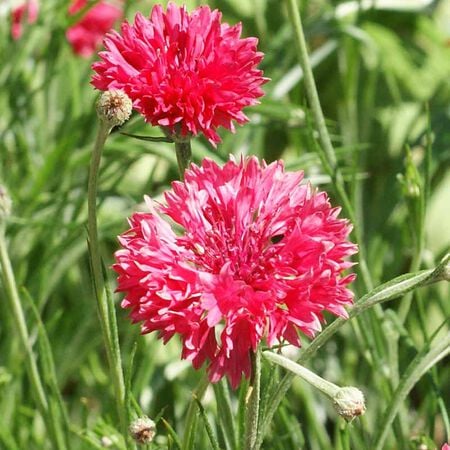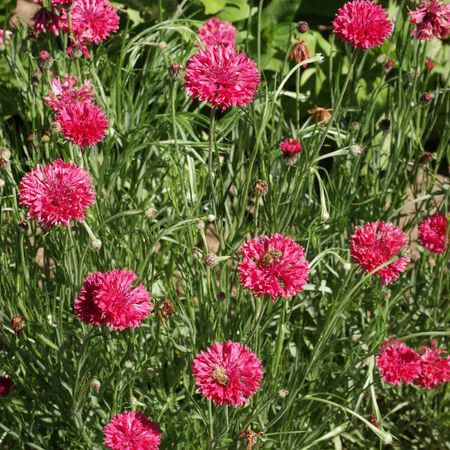Tall Red, Centaurea Seeds
Key Attributes
Product Details
Weight
.01Plant Height
28-36"Botanical Name
Centaurea cyanusSeed Type
SeedAdditional Characteristics
Attracts Pollinators, Attracts BirdsSeeds Per Gram
196Seeds Per Pound
89,000Packet
500 SeedsSow Depth
1/4"Seeds Per Ounce
5,563Breed
Open-pollinatedSun
Full Sun / Partial ShadeUses
Cut FlowersLife Cycle
AnnualSow Method
Direct Sow,TransplantSow Per 1000 Sq Ft
4 OuncesCategories
FlowersDays To Maturity (# Days)
75Seeds Per Acre
15 lbsComponents
Growing Instructions
![]() Learning Download: How to Grow Cornflower
Learning Download: How to Grow Cornflower
The Cornflower is also known as the bachelor button, and it can be harvested in the summer or fall depending on when it is planted. Cornflower can reach 3 feet in height and attract birds and butterflies. Blooms can reach up to 1 inch wide.
Before Planting: Cornflower is not picky when it comes to soil conditions, but it does prefer a sunny location to grow. Prior to planting, loosen the soil in the garden and amend it with 4 inches of compost.
Planting: Plant the seeds one week before the last frost of the season. Plant them 1/4 inch deep and 1 inch apart.
Watering: Water the flowers 1 inch per week.
Fertilizer: Feed the Cornflower with an all-purpose fertilizer once a month.
Days to Maturity: Cornflowers begin flowering in early June and will continue to flower through August. Sometimes, they can even begin flowering in March if planted in a warmer climate.
Harvesting: Cornflowers make a great cut flower to bring inside and also work for dried flower arrangements since the flowers retain their color even after being dried.
Tips: Cornflowers are hardy, but they can be susceptible to mold and mildew if overwatered and not given enough space for good air circulation.
Shipping Schedule
Our Seed Promise
 "Agriculture and seeds" provide the basis upon which our lives depend. We must protect this foundation as a safe and genetically stable source for future generations. For the benefit of all farmers, gardeners and consumers who want an alternative, we pledge that we do not knowingly buy or sell genetically engineered seeds or plants.
"Agriculture and seeds" provide the basis upon which our lives depend. We must protect this foundation as a safe and genetically stable source for future generations. For the benefit of all farmers, gardeners and consumers who want an alternative, we pledge that we do not knowingly buy or sell genetically engineered seeds or plants.
The mechanical transfer of genetic material outside of natural reproductive methods and between genera, families or kingdoms, poses great biological risks as well as economic, political, and cultural threats. We feel that genetically engineered varieties have been insufficiently tested prior to public release. More research and testing is necessary to further assess the potential risks of genetically engineered seeds. Further, we wish to support agricultural progress that leads to healthier soils, to genetically diverse agricultural ecosystems, and ultimately to healthy people and communities.
To learn more about the "Safe Seed Pledge" please visit www.councilforresponsiblegenetics.org.
Key Attributes
Product Details
Weight
.01Plant Height
28-36"Botanical Name
Centaurea cyanusSeed Type
SeedAdditional Characteristics
Attracts Pollinators, Attracts BirdsSeeds Per Gram
196Seeds Per Pound
89,000Packet
500 SeedsSow Depth
1/4"Seeds Per Ounce
5,563Breed
Open-pollinatedSun
Full Sun / Partial ShadeUses
Cut FlowersLife Cycle
AnnualSow Method
Direct Sow,TransplantSow Per 1000 Sq Ft
4 OuncesCategories
FlowersDays To Maturity (# Days)
75Seeds Per Acre
15 lbsComponents
Growing Instructions
![]() Learning Download: How to Grow Cornflower
Learning Download: How to Grow Cornflower
The Cornflower is also known as the bachelor button, and it can be harvested in the summer or fall depending on when it is planted. Cornflower can reach 3 feet in height and attract birds and butterflies. Blooms can reach up to 1 inch wide.
Before Planting: Cornflower is not picky when it comes to soil conditions, but it does prefer a sunny location to grow. Prior to planting, loosen the soil in the garden and amend it with 4 inches of compost.
Planting: Plant the seeds one week before the last frost of the season. Plant them 1/4 inch deep and 1 inch apart.
Watering: Water the flowers 1 inch per week.
Fertilizer: Feed the Cornflower with an all-purpose fertilizer once a month.
Days to Maturity: Cornflowers begin flowering in early June and will continue to flower through August. Sometimes, they can even begin flowering in March if planted in a warmer climate.
Harvesting: Cornflowers make a great cut flower to bring inside and also work for dried flower arrangements since the flowers retain their color even after being dried.
Tips: Cornflowers are hardy, but they can be susceptible to mold and mildew if overwatered and not given enough space for good air circulation.
Shipping Schedule
Our Seed Promise
 "Agriculture and seeds" provide the basis upon which our lives depend. We must protect this foundation as a safe and genetically stable source for future generations. For the benefit of all farmers, gardeners and consumers who want an alternative, we pledge that we do not knowingly buy or sell genetically engineered seeds or plants.
"Agriculture and seeds" provide the basis upon which our lives depend. We must protect this foundation as a safe and genetically stable source for future generations. For the benefit of all farmers, gardeners and consumers who want an alternative, we pledge that we do not knowingly buy or sell genetically engineered seeds or plants.
The mechanical transfer of genetic material outside of natural reproductive methods and between genera, families or kingdoms, poses great biological risks as well as economic, political, and cultural threats. We feel that genetically engineered varieties have been insufficiently tested prior to public release. More research and testing is necessary to further assess the potential risks of genetically engineered seeds. Further, we wish to support agricultural progress that leads to healthier soils, to genetically diverse agricultural ecosystems, and ultimately to healthy people and communities.
To learn more about the "Safe Seed Pledge" please visit www.councilforresponsiblegenetics.org.




